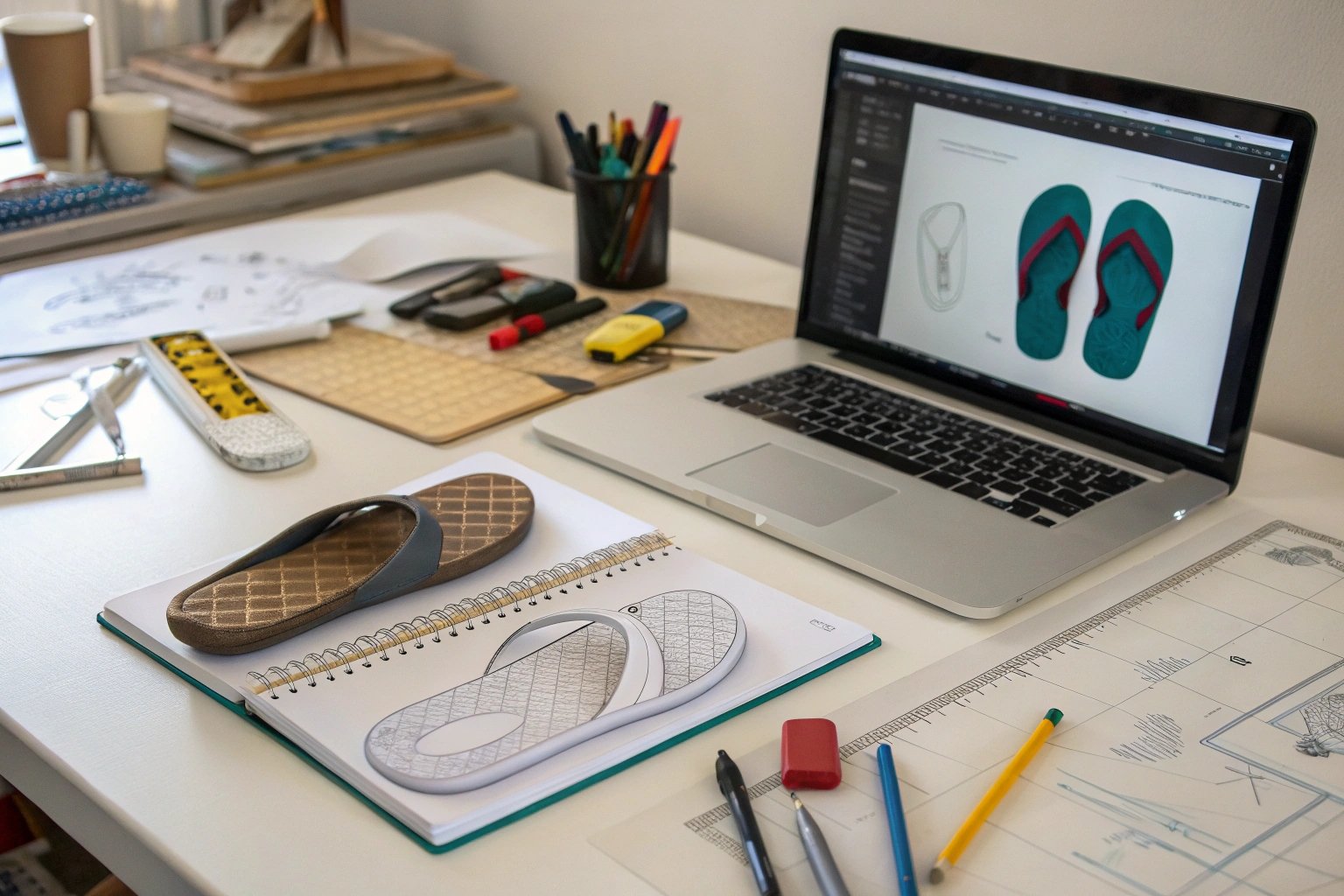Are you struggling to find a reliable supplier for your slipper brand? Do you want to know how quality slippers are made?
The standardized production process of plastic slippers includes design, mold making, material preparation, injection molding, quality control, and packaging. Each step is crucial to ensure the slippers meet quality and safety standards.

Let’s explore the details behind the production process, so you can understand how we make high-quality slippers.
How to design a new plastic slipper?
Having trouble turning your slipper ideas into reality? Don’t worry, it all starts with a good design.
Designing a new plastic slipper involves sketching, 3D modeling, and prototyping. This ensures the slipper is both stylish and functional before mass production.

First, we start with sketches to explore different shapes and styles. This stage is all about brainstorming and getting creative. I often look at current fashion trends and customer preferences to inspire new designs. Once we have a few promising sketches, we move on to 3D modeling. Using software like SolidWorks or AutoCAD, we create a digital model of the slipper. This allows us to see the design from all angles and make necessary adjustments. The 3D model also helps in calculating material requirements and identifying potential manufacturing challenges.
| Step | Description | Tools Used |
|---|---|---|
| Sketching | Initial brainstorming and drawing of various slipper designs. | Pencils, paper, design software |
| 3D Modeling | Creating a digital model of the slipper for detailed visualization and analysis. | SolidWorks, AutoCAD, Rhino |
| Prototyping | Making a physical sample to test the design and identify any issues. | 3D printers, CNC machines, hand tools |
After the 3D model is complete, we create a prototype. This is a physical sample of the slipper that allows us to test the design for comfort, durability, and manufacturability. We use 3D printers or CNC machines to create the prototype. We can also make a prototype by hand using traditional methods. The prototype is then tested by our team and potential customers to gather feedback. Based on the feedback, we make any necessary changes to the design before moving on to the next step.
What is the importance of mold making in slipper production?
Are you aware that the mold determines the shape and quality of the slipper? Do you understand why precision is crucial?
Mold making is crucial because it creates the cavity that shapes the plastic slipper during injection molding. A well-made mold ensures consistent quality and reduces defects.

The mold-making process starts with creating a detailed design of the mold based on the final slipper design. This design includes all the necessary features such as injection points, cooling channels, and ejection mechanisms. Once the design is finalized, we select the appropriate material for the mold, usually steel or aluminum. Steel molds are more durable and suitable for high-volume production, while aluminum molds are less expensive and ideal for smaller runs. The mold material is then machined using CNC machines to create the mold cavity.
| Aspect | Description | Material Options |
|---|---|---|
| Mold Design | Detailed planning of the mold’s features, including injection points and cooling. | CAD software |
| Material Choice | Selecting the right material for the mold based on durability and cost. | Steel, Aluminum |
| Machining | Using CNC machines to precisely create the mold cavity. | CNC machines |
After machining, the mold is polished to ensure a smooth surface. This helps in producing slippers with a glossy finish. The mold is then tested to ensure it meets the required specifications. Any necessary adjustments are made before the mold is approved for production. I remember one time we had to remake a mold because the dimensions were slightly off. It was a costly mistake, but it taught us the importance of precision in mold making.
Why is material selection important for plastic slippers?
Do you know what materials make the best plastic slippers? Are you aware of the impact of material choice on comfort and durability?
Material selection is important because it affects the slipper’s comfort, durability, and safety. Common materials include EVA, PVC, and rubber, each with unique properties.

EVA (Ethylene-vinyl acetate) is a popular choice for plastic slippers because it is lightweight, flexible, and provides good cushioning. PVC (Polyvinyl chloride) is another option, known for its durability and water resistance. Rubber slippers are often chosen for their excellent grip and durability. When selecting materials, we consider factors such as cost, availability, and environmental impact. We also ensure that the materials meet safety standards and are free from harmful chemicals.
| Material | Properties | Advantages | Disadvantages |
|---|---|---|---|
| EVA | Lightweight, flexible, good cushioning | Comfortable, affordable, versatile | Less durable than rubber |
| PVC | Durable, water-resistant | Long-lasting, easy to clean, cost-effective | Can be stiff, less environmentally friendly |
| Rubber | Excellent grip, durable | Good for outdoor use, slip-resistant, long-lasting | Heavier, more expensive |
For example, for children’s slippers, we prioritize materials that are non-toxic and hypoallergenic. We also conduct thorough testing to ensure that the materials can withstand wear and tear. I recall a project where we switched to a more sustainable EVA material, which improved our brand’s image and resonated with our customers.
How does injection molding create the final slipper?
Are you curious about how plastic slippers get their shape? Do you want to understand the process of injection molding?
Injection molding involves injecting molten plastic into the mold cavity, where it cools and solidifies into the final slipper shape. This method allows for mass production with consistent quality.

The injection molding process begins with heating the plastic material until it melts. The molten plastic is then injected into the mold cavity under high pressure. The mold is cooled to allow the plastic to solidify. Once the plastic has cooled and hardened, the mold is opened, and the slipper is ejected. This process is repeated for each slipper, allowing for mass production with consistent quality.
| Stage | Description | Key Factors |
|---|---|---|
| Melting | Heating the plastic material until it becomes molten. | Temperature control, material viscosity |
| Injection | Injecting the molten plastic into the mold cavity under high pressure. | Pressure control, injection speed |
| Cooling | Cooling the mold to allow the plastic to solidify. | Cooling time, mold temperature |
| Ejection | Opening the mold and ejecting the finished slipper. | Ejection mechanism, mold design |
The injection molding process requires precise control of temperature, pressure, and timing to ensure that the slippers are free from defects. We use advanced machinery and skilled technicians to monitor the process and make any necessary adjustments. I’ve seen firsthand how a small change in temperature can affect the quality of the slippers, highlighting the importance of attention to detail.
How to ensure the quality of plastic slippers?
Worried about the quality of your slipper production? Do you want to know how to avoid defects and ensure customer satisfaction?
Quality control involves inspecting slippers for defects, checking dimensions, and testing durability. This ensures that only high-quality slippers reach the customer.

Quality control is a critical step in the production process. It involves inspecting the slippers for defects such as cracks, bubbles, and surface imperfections. We also check the dimensions to ensure they meet the required specifications. Durability testing is conducted to assess the slipper’s resistance to wear and tear. This includes testing the strength of the sole and the straps. Slippers that pass the quality control checks are approved for packaging and shipping.
| Checkpoint | Description | Criteria |
|---|---|---|
| Visual Inspection | Inspecting for defects such as cracks, bubbles, and surface imperfections. | No visible defects, uniform color and texture |
| Dimensional Check | Checking the dimensions to ensure they meet the required specifications. | Accurate measurements within tolerance limits |
| Durability Test | Assessing the slipper’s resistance to wear and tear. | Sole strength, strap strength, abrasion resistance |
Our quality control team is trained to identify even the smallest defects. We use specialized equipment to measure dimensions and conduct durability tests. I am very proud of our rigorous quality control process, which has helped us maintain a high level of customer satisfaction.
What are the packaging and shipping considerations for slippers?
Want to ensure your slippers arrive safely and in good condition? Do you know the best practices for packaging and shipping?
Packaging and shipping involve wrapping slippers to prevent damage during transit. Proper labeling and documentation are also essential for smooth delivery.

The packaging process starts with wrapping each pair of slippers in a protective material such as plastic or paper. The slippers are then placed in boxes or cartons, depending on the quantity and size. We use sturdy packaging materials to prevent damage during transit. The boxes are labeled with the necessary information such as product name, quantity, and shipping address. Proper documentation such as invoices and packing lists are included to ensure smooth delivery.
| Aspect | Description | Key Considerations |
|---|---|---|
| Wrapping | Wrapping each pair of slippers in a protective material. | Plastic, paper, bubble wrap |
| Boxing | Placing the wrapped slippers in boxes or cartons. | Sturdy materials, appropriate size |
| Labeling | Labeling the boxes with product information and shipping address. | Clear and accurate information, compliance with regulations |
| Documentation | Including invoices and packing lists for smooth delivery. | Accurate and complete documentation |
We work with reliable shipping companies to ensure that the slippers are delivered on time and in good condition. We also track the shipments to monitor their progress and address any potential issues. I’ve learned that proper packaging and shipping are just as important as the production process in ensuring customer satisfaction.
Conclusion
The standardized production process of plastic slippers involves several key steps, from design to packaging. Each step is crucial for producing high-quality slippers that meet customer expectations.

